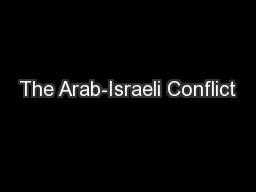

2000Present PeopleThings to Know Hamas A radical Islamist political party and militant group Currently controls the Gaza Strip Its charter calls for the obliteration of Israel and the killing of Jews ID: 323396
Download Presentation The PPT/PDF document "The Arab-Israeli Conflict" is the property of its rightful owner. Permission is granted to download and print the materials on this web site for personal, non-commercial use only, and to display it on your personal computer provided you do not modify the materials and that you retain all copyright notices contained in the materials. By downloading content from our website, you accept the terms of this agreement.
Slide1
The Arab-Israeli Conflict
2000-PresentSlide2
People/Things to Know
Hamas: A radical Islamist political party and militant group. Currently controls the Gaza Strip. Its charter calls for the “obliteration” of Israel and the killing of Jews.
Fatah: A secular Palestinian political party. Founded by Yasser Arafat.
Likud: The most powerful political party in Israel. Conservative, nationalist, very pro-military. Its charter rejects the idea of a Palestinian state.
IDF: Israeli Defense Forces
Mahmoud Abbas: Leader of Fatah, the PLO and current president of the Palestinian Authority.
Benjamin Netanyahu: Leader of Likud and current Prime Minister of Israel.
Iron Dome: An Israeli defense system that knocks down rockets aimed for Israel.Slide3
Issues
How will the land be divided between Israel and a future Palestinian state?
Israeli settlements-Israelis are encouraged to move to the West Bank and build homes, on territory that Palestinians believe is theirs.
Security-Israel is subject to frequent rocket attacks and suicide bombers by Hamas. Hamas attempts to build underground tunnels to enter Israel for attacks.
Palestinian quality of life-In the name of security, Israel forces Palestinians to go through checkpoints, blocks off certain roads, and destroys Palestinian homes and farms if they believe tunnels are below. A barrier separates the West Bank from Israel and Gaza is blockaded by the Israeli navy.
Proportionality-In most conflicts between Israel and Palestine, many more Palestinians are killed than IsraelisSlide4
Issues II
Water-Israel consumes most of the water resources for both countries.
Economics-Israel
is a rich, prosperous country, while most Palestinians live in poverty
.
Jerusalem-Who will control the city, particularly its holy sites in and around the Temple Mount?
Palestinian refugees-Will Palestinian refugees have the right to return to their former homes?
Emotions-How can decades of anger, resentment, and violence be overcome?Slide5
2000-2005 Second Intifada
Israel’s then-Prime Minister, Ariel Sharon, made a visit to the Temple Mount and claimed it for Israel forever
Palestinians began rioting, and the conflict quickly escalated-many terrorist attacks and attacks by the IDF
About 1000 Israelis and 5000 Palestinians were killed
Results: Israel decides with withdraw from Gaza, build a barrier around the West BankSlide6
2006: The Rise of Hamas
In 2005, Israel decided to withdraw all troops and settlements from Gaza.
The people of Gaza soon elected Hamas to take Fatah’s place as the ruling party in Gaza
Hamas began launching daily rocket attacks against IsraelSlide7
2006 Second Lebanon War
Hezbollah, a militant group in Lebanon, began launching attacks against Israel.
Israel invaded southern Lebanon to stop the attacks.
Hezbollah keeps its weapons in civilian areas, forcing Israel to decide whether or not to attack those areas-a tactic Hamas uses as well.Slide8
2007 Battle of Gaza
Hamas launched attacks against Fatah throughout Gaza
Fatah members were attacked and assassinated
Since then, there have been two Palestinian governments-Hamas in Gaza, Fatah in the West BankSlide9
2007 Annapolis Conference
Israel, Fatah leaders, and other Middle Eastern countries attend talks in Annapolis, Maryland
Both sides agree upon a “two state solution”
The majority of Israeli citizens support a two state solutionSlide10
2008-2009 Operation Cast Lead, 2012 Operation Pillar of Defense
Israel launches attacks into Gaza to stop the firing of rockets against Israeli towns and villages and to destroy Hamas weapons
Hamas launches attacks from densely populated areas
Results: Many civilians are killed, and Gaza’s economy and infrastructure is badly damagedSlide11
2013-2014 Peace Talks
Peace talks between the sides were led by Secretary of State John Kerry
Promising developments collapsed when Hamas and Fatah announced they were would be working together
Hamas continues to call for the destruction of IsraelSlide12
2014 War
3 Israeli teens are kidnapped and murdered, then a Palestinian teen was kidnapped and murdered
Hamas launched 117 rockets, Israel launched 80 airstrikes on Gaza
2100 Palestinians killed, 70 Israelis are killed